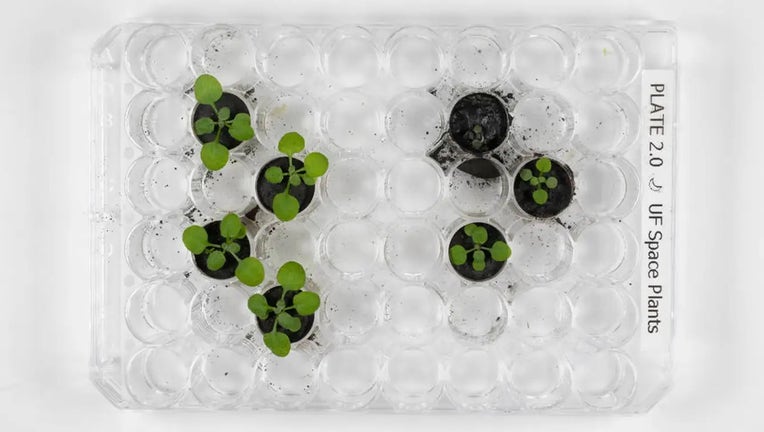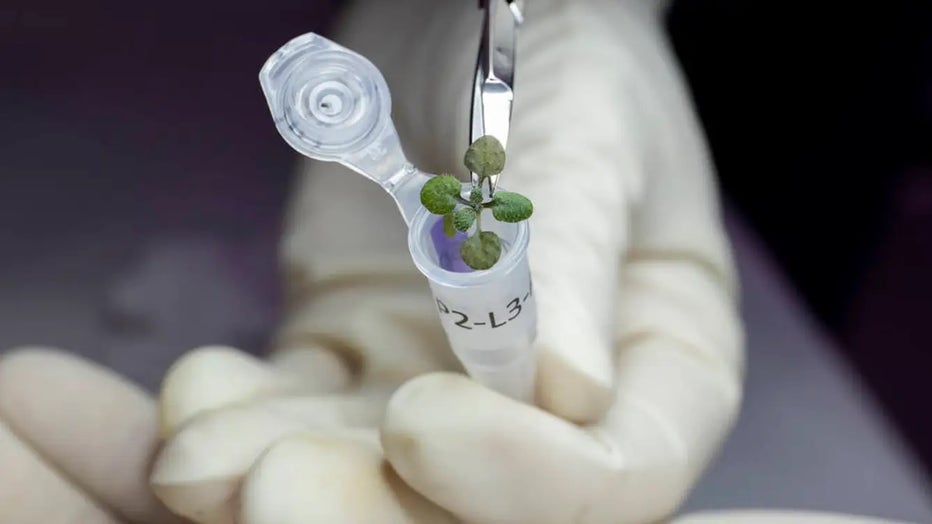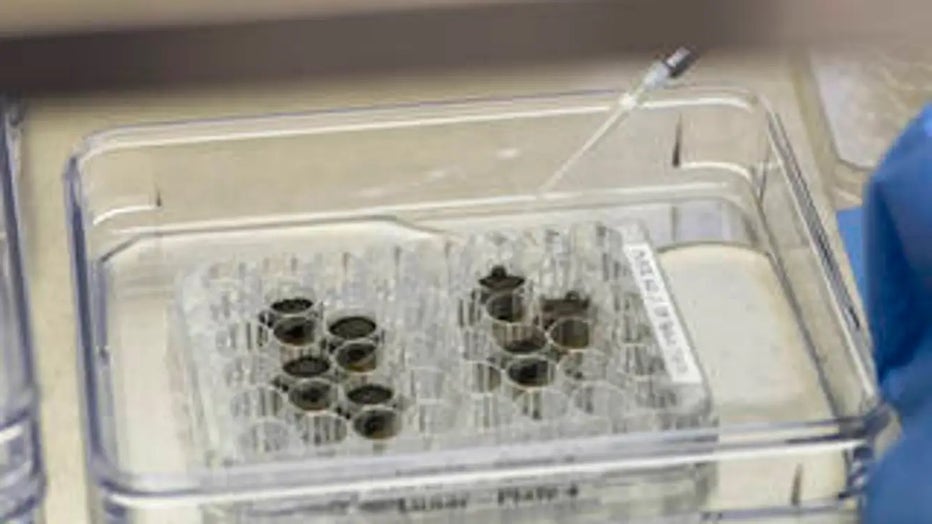Plants can grow on the moon but don’t expect a robust garden just yet

By day 16, there were clear physical differences between plants grown in the volcanic ash lunar simulant, left, compared with those grown in the lunar soil, right.(UF/IFAS photo by Tyler Jones)
Scientists say that plants can grow on the moon, but they might not be as plentiful as once hoped.
As part of an ongoing effort to study samples from space, Apollo astronauts previously collected samples of lunar surface material, known as regolith, and brought them back to Earth.
NASA says that now, 50 years later, researchers used three of those samples to grow plants for the first time successfully.
Researchers at the University of Florida's Space Plants Lab grew Arabidopsis thaliana in the nutrient-poor lunar soil known as regolith. Arabidopsis thaliana is a well-researched small flowing plant native to Eurasia and Africa. They are a relative of mustard greens and other cruciferous vegetables.
50-YEAR-OLD FROZEN MOON SAMPLES TO HELP NASA'S FUTURE MISSIONS
When starting the research, University of Florida scientists worked to find answers to two crucial questions.
"We first asked the question of whether plants can grow in regolith. And second, how might that one day help humans have an extended stay on the moon," said Robert Ferl, a professor in the Horticultural Sciences Department at the University of Florida.
Ferl and Horticultural scientists Anna-Lisa Paul are trailblazers in growing plants in space. They have sent plant experiments to space on the space shuttle, the International Space Station, and Blue Origin and Virgin Galactic suborbital spaceflights.
Planting on the moon
The answer to the University of Florida scientists’ first question was a resounding ‘yes.’ Plants can grow in the moon’s soil.
NASA says that while plants did grow, they were not as robust as plants grown in Earth soil or even as those in the control group grown in a lunar simulant made from volcanic ash.
"To explore further and to learn about the solar system we live in, we need to take advantage of what’s on the moon, so we don’t have to take all of it with us," said Jacob Bleacher, the Chief Exploration Scientist supporting NASA’s Artemis program at NASA Headquarters in Washington.

Placing a plant grown during the experiment in a vial for eventual genetic analysis.( UF/IFAS photo by Tyler Jones)
When it sends robots to the moon’s south pole, NASA hopes that they will find water that future astronauts can use.
A WHOLE BUNCH OF AMERICAN-MADE ROBOTS ARE HEADED TO THE MOON
"What’s more, growing plants is the kind of thing we’ll study when we go. So, these studies on the ground lay the path to expand that research by the next humans on the moon," Bleacher said.
Dirt from under the lunar rover bumper used to grow first plants
The team of scientists used samples from Apollo 11, 12 and 17. It took 10 years of requests for soil before the UF research team got its sample.
"These samples are our national treasure. They're rare, they're precious," Paul told FOX Weather. "Most scientists that are using these materials are geologists or physicists or chemists that can take a look at the materials, do whatever analysis they want, and then they have to go back to NASA in as pristine a status as possible."
However, gardening is not a clean science.
"We had to convince NASA that, yeah, biology is messy, so we understand these samples are on loan to us, and we will send them all back to you when we're done, but they will not be in the same state in which we receive them, because that's just the nature of biology," Paul explained.

Anna-Lisa Paul tries moistening the lunar soils with a pipette. The scientists found that the soils repelled water (were hydrophobic), causing the water to bead-up on the surface. Active stirring of the material with water was required to break the h
Ultimately, the UF Space Plants Lab was granted 12 grams of lunar soil, four grams from Apollo 11, 12, and 17. The exact sample Ferl and Paul requested was the moon dirt from under a lunar rover collected during Apollo 17, thinking it would be less popular among geologists.
"It was a mixture of stuff that had gotten stuck underneath the bumper of the rover," Paul said.
As the Apollo 17 astronauts prepared to return to Earth, NASA Astronaut Harrison Schmitt took some lunar dirt on the bumper and used it to help buffer "more important geology samples" on the return mission, Paul explained.
"We thought, 'Wow, you know, we'll use that because nobody else would really care about that," Paul said.
NASA's Lunar Sample Curation team gave the Space Plants Lab even more than they asked for to further their research.
A gram of the regolith was allotted for each plant, and the team added water and seeds to the samples. The terrarium boxes were then placed in a clean room, and researchers added nutrient solutions daily.
Paul said they were pretty confident the seeds would sprout, but there is always a fear with every experiment, it won't go as planned. After two days, the researchers returned to the growth chamber room and were surprised at what they found.
"We were quite amazed to see that every seed germinated. They all germinated. Whether you were on lunar regolith or on this simulant," Paul said. "Everybody was beautiful and green and tiny, but they were all growing. So that first shock of, 'Wow, there's nothing impeding the germination.'"
Scientists say that after day six, it was clear that the plants were not as robust as the control group plants growing in volcanic ash, and the plants were growing differently depending on which type of sample.

Rob Ferl, left, and Anna-Lisa Paul looking at the plates filled part with lunar soil and part with control soils, now under LED growing lights. At the time, the scientists did not know if the seeds would even germinate in lunar soil.(UF/IFAS photo by
The plants were said to have grown more slowly and had stunted roots. Some even had stunted leaves and sported reddish pigmentation.
The plants were harvested after 20 days, just before the plants started to flower.
After researchers studied the proteins within the plants, they found patterns of genes were under stress and reacted the way they’d seen when grown in harsh environments.
Ultimately, the plants reacted differently depending on the sample and which moon area was used. Researchers said that the plants grown in Apollo 11 samples were not as robust as the other two sets.
Sowing seeds for future research
While the plants weren’t as strong as they hoped, the research will help to study the lunar regolith further and help them understand where to find the best soil to plant on the moon.
"It was extraordinarily emotional from the perspective as we're sitting there looking at these tiny little green things growing on extraterrestrial materials. We are the first humans to ever see this sight we're looking at right now," Paul said. "To be part of the, you know, the lunar exploration legacy, even this by this small bit, was really special and feeling like we were making the bridge to the next step of lunar exploration was just awesome."
NASA DEVELOPS "MOON DUSTER" TO ZAP AWAY LUNAR DUST
The UF Space Plants Lab will hang onto its sample to continue to understand how plants and lunar soil interact.
Pieces of the moon will help this mission identify the growth of plants and future other future missions.
"Hopefully, by the time lunar farmers are scooping up regolith to put into the greenhouse pots, we will have learned quite a bit more to tell them what are the kind of things that we need to do to ameliorate some of the stress effects of lunar regolith," Paul said.
NASA plans to return humans to the moon by 2025 under the Artemis program and build a long-term base for research.

